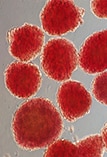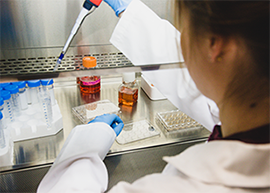Research Updates
Anxiety affects many with end-stage renal disease: Anxiety is a common yet frequently overlooked issue in people with end-stage renal disease (ESRD) treated with maintenance hemodialysis, and may account for seemingly irrational behaviors, according to an NIDDK-led research review. For example, the people may demand to stop hemodialysis treatment prematurely or may insist on having a specific dialysis technician. The authors suggest that anxiety disorder screening may be useful for those with ESRD receiving hemodialysis. People with suspected anxiety disorders should be referred to mental health professionals for treatment. The review was published September 2016 in the Clinical Journal of the American Society of Nephrology.

Clinical islet network improves transplantation manufacturing for human islets: Researchers in the NIH-funded Clinical Islet Transplantation Network developed a unified, improved method for the manufacture of human pancreatic islets. Transplantation of these islets has shown promise in trials in people with type 1 diabetes and recurrent potentially life-threatening hypoglycemia, despite expert care. Researchers sought to harmonize multiple manufacturing aspects. Islets through this process were successfully transplanted into 48 people, most of whom then demonstrated protection from low blood sugar levels and near-normal A1c levels. Results were published in Diabetes.
Gene identified for hyperparathyroidism: An NIDDK-led team identified a new gene for familial primary hyperparathyroidism. The findings may inform treatment options for people at risk of the condition. The study results were published in The American Journal of Human Genetics.
HbA1c predicts diabetes in American Indian children: In a longitudinal study of American Indian children and adolescents, an NIDDK-led team found that elevated levels of HbA1c – which reflects chronic levels of blood glucose – is as strong a predictor of type 2 diabetes in children as it is in adults. HbA1c is only beginning to be accepted as a diabetes predictor in adults, and no published data has described its long-term predictive value in children who are overweight or obese. The findings, which may help healthcare providers identify children and adolescents at high risk of diabetes, were published in Diabetes Care.
Hunger may be at top of motivational hierarchy: NIDDK researchers found that hunger outweighed other physical drives, including thirst, fear and social needs, in mice. What the investigators discovered may help to shed light on why hunger can be such a powerful motivating influence. The study results were published in Neuron.
Illuminating the Druggable Genome program advances to implementation phase: Launched in 2014, the NIH Common Fund's Illuminating the Druggable Genome (IDG) Program enables researchers to explore understudied proteins with the potential to be modified by medicines. In November, a request for grant applications moved IDG into its implementation phase. The program plans to allocate $54 million to advance research through the development, broad dissemination, and use of community scientific resources to study human proteins for which publicly available information or active research is lacking. IDG aims to catalyze the discovery of novel biology. The program is administered by NIDDK, the National Center for Advancing Translational Sciences and the National Cancer Institute.
Improving blood glucose estimates: To improve the accuracy of blood glucose estimates, a team from Harvard Medical School and Massachusetts General Hospital investigated individual biological differences that may affect A1C results. The researchers determined the average red blood cell age for people based on the relationship between continuous glucose measurements and glycated hemoglobin measurements taken from a blood test. Using this information in the model, each person's average blood glucose levels could be calculated based on A1C tests with higher accuracy than the current standard method, reducing estimation errors by more than 50 percent. The research was funded in part by NIDDK and an NIH Director's New Innovator Award. Results published in Science Translation Medicine.

Modifying neural activity stops feeding in mice: By identifying the inhibitory input to hunger-responding neurons, a team including NIDDK investigators was able to shut down feeding behavior in hungry mice. The team found that these inhibitory neurons increased their activity in the presence of food, with high-calorie foods such as chocolate producing even more of an effect. The findings were published in Nature Neuroscience.
NIH task force formed to develop first nutrition strategic plan: The NIH Nutrition Research Task Force was established in October to coordinate and accelerate progress in nutrition research across the NIH and guide the development of the first NIH-wide strategic plan for nutrition research for the next 10 years. It will draw from experts across multiple fields, as nutrition affects both a wide range of diseases — including diabetes, cancer, obesity and heart disease — as well as overall health and development.
Weight loss leads to strong increase in appetite: Analysis of a trial that used the drug canagliflozin found that as people lost weight, appetite increased proportionately, leading to consumption of more calories and weight loss plateau, or leveling off. The findings provide the first measurement in people of how strongly appetite counters weight loss as part of the body's feedback control system regulating weight. Results were published in Obesity.
Wound-healing role identified for protein-folding gene in mice: NIH researchers have identified a novel role for a gene known as heat shock protein 60 (Hsp60), finding that it is critical in tissue regeneration and wound healing. The study found that topical treatment of an Hsp60-containing gel dramatically accelerates wound closure in a diabetic mouse model. The study also describes the mechanism by which this works, finding that Hsp60 protein is released at the site of injury, signaling wound healing to initiate. The study published in npj Regenerative Medicine.
